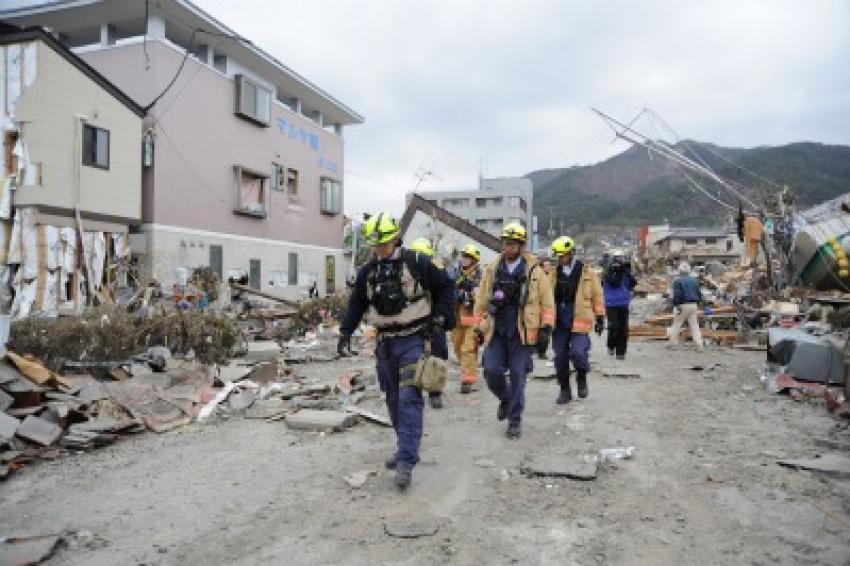Japan Crisis Day 8: Most Recent Developments in Japan's Nuclear Crisis
TEPCO Tries to Restore Power to Reactors 1 and 2
Following are main developments after a massive earthquake and tsunami devastated northeast Japan and crippled a nuclear power station, raising the risk of uncontrolled radiation.
• Fire trucks are to keep dousing reactor No.3 at the crippled Fukushima Daiichi plant, Japanese Defense Minister Toshimi Kitazawa says. Teams are trying to restore a power cable to reactors 1 and 2 at the plant to restart pumps needed to pour cold water on overheating fuel rods, but that work would stop to enable the fire trucks to proceed with spraying. Plant operator TEPCO acknowledges that preparatory work to reconnect the power "has so far not progressed as fast as we had hoped." Workers are constantly checked for radiation levels.
• G7 industrialized countries agreed, after a teleconference of finance ministers, on concerted intervention, the first since 2000, to restrain the yen, hoping to calm global markets.
• The U.S. dollar surges two yen as far as 81.49 yen, leaving behind a record low of 76.25 on Thursday, after the Bank of Japan began to sell yen and other central banks agreed to intervene later. Japanese shares jump 2 percent, but were still down about 11% on the week.
• Nuclear agency spokesman says the key aim is to get water into spent fuel pools, with reactor No. 3, containing plutonium fuel, the priority. Spokesman says a "Chernobyl solution" of burying the reactors in sand and concrete "is in the back of our minds", but cooling the reactors is the main task. Smoke or steam earlier seen rising from reactors 2, 3 and 4.
• The head of the U.S. Nuclear Regulatory Commission, Gregory Jaczko, says the cooling pool at reactor No. 4 may have run dry. He says it could take weeks to cool the reactors.
• World Health Organization believes the spread of radiation is localized and poses no immediate risk to human health.
• Head of the U.N. Nuclear watchdog, the IAEA, due back in his native Japan on Friday. His aide calls the situation at the plant as "reasonably stable" with no major worsening.
• U.S. President Barack Obama says he has requested a comprehensive review of U.S. nuclear facilities, while maintaining backing for atomic energy. He pledged support for Japan while seeking to aid and evacuate Americans.
• United States sends aircraft to fly out nationals from Japan, authorizes voluntary departure of family members of diplomatic staff. The Pentagon says it will allow all dependents of U.S. military personnel to leave Japan's Honshu island while Homeland Security Secretary Janet Napolitano says passengers and cargo arriving from Japan would be checked for radiation.
• Eighteen months before the crisis, U.S. diplomats had lambasted the IAEA's safety chief for incompetence, especially when it came to the nuclear power industry in his native Japan, according to cables sent by the U.S. embassy in Vienna to Washington. The cables, obtained by WikiLeaks and reviewed by Reuters, singled out Tomihiro Taniuchi, until last year the IAEA's head of safety and security.
• U.S. to fly a drone over the complex to assess the emergency. Australia again urges nationals in Tokyo and eight prefectures to consider leaving Japan. That warning was because of infrastructure problems, not the fear of radiation.
• Tokyo is safe for international travelers, the Japanese Red Cross says, but airlines pull in extra, larger aircraft to help thousands of people leave and some begin screening aircraft, passengers and crew for radiation.
• Estimates of losses to Japanese output from damage to buildings, production and consumer activity range from 10 to 16 trillion yen ($125-$200 billion), up to 1 1/2 times the economic losses from the 1995 Kobe earthquake.
• Nuclear crisis diverts attention from the tens of thousands affected by last week's earthquake and tsunami. About 850,000 households in the north without electricity in near-freezing weather. Death toll is expected to exceed 10,000.





